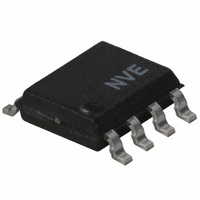IL612A-3E NVE, IL612A-3E Datasheet - Page 10

IL612A-3E
Manufacturer Part Number
IL612A-3E
Description
ISOLATOR TX/RX CMOS 8SOIC
Manufacturer
NVE
Series
IsoLoop®r
Datasheet
1.IL610A-1E.pdf
(17 pages)
Specifications of IL612A-3E
Inputs - Side 1/side 2
1/1
Number Of Channels
2
Isolation Rating
2500Vrms
Voltage - Supply
3 V ~ 5.5 V
Data Rate
10Mbps
Propagation Delay
20ns
Output Type
Open Drain
Package / Case
8-SOIC (3.9mm Width)
Operating Temperature
-40°C ~ 85°C
No. Of Channels
2
Supply Current
2mA
Supply Voltage Range
3V To 5.5V
Digital Ic Case Style
SOIC
No. Of Pins
8
Operating Temperature Range
-40°C To +85°C
Rohs Compliant
Yes
Lead Free Status / RoHS Status
Lead free / RoHS Compliant
Other names
390-1090-5
Available stocks
Company
Part Number
Manufacturer
Quantity
Price
Company:
Part Number:
IL612A-3E
Manufacturer:
MATSUSHIT
Quantity:
12
Electromagnetic Compatibility and Magnetic Field Immunity
Because IL600-Series Isolators are completely static, they have the lowest emitted noise of any non-optical isolators.
IsoLoop devices operate by imposing a magnetic field on a GMR sensor, which translates the change in field into a change in logic
state. There are several ways of enhancing magnetic field immunity. The devices are manufactured with a magnetic shield above
the sensor. The shield acts as a flux concentrator to boost the magnetic signal from the internal coil, and as a shield against external
magnetic fields. The shield absorbs surrounding stray flux until it becomes saturated. At saturation the shield is transparent to
external applied fields, and the GMR sensor may react to the field. To compensate for this effect, IsoLoop Isolators use
Wheatstone Bridge structures that are only sensitive to differential magnetic fields.
Providing a larger internal field will reduce the effect of an external field on the GMR sensor.
Immunity to external magnetic fields can also be enhanced by proper orientation of the device with respect to the field direction,
the use of differential signaling, and field boosting capacitors.
Two ways to enhance immunity to external magnetic field are summarized below.
1. Orientation of the device with respect to the field direction
2. Differential Signaling and Boost Capacitors
Regardless of orientation, driving the coil differentially improves magnetic immunity. This is because the logic high state is driven
by an applied field instead of zero field, as is the case with single-ended operation. The higher the coil current, the higher the
internal field, and the higher the immunity to external fields.
Optimal magnetic immunity is achieved by adding the boost capacitor.
Data Rate and Magnetic Field Immunity
It is easier to disrupt an isolated DC signal with an external magnetic field than it is to disrupt an isolated AC signal. Similarly, a
DC magnetic field will have a greater effect on the device than an AC magnetic field of the same effective magnitude. For
example, signals with pulses greater than 100 s long are more susceptible to magnetic fields than shorter pulse widths.
An applied field in the “H1” direction is the worst case for
magnetic immunity. In this case the external field is in the same
direction as the applied internal field. In one direction it will
tend to help switching; in the other it will hinder switching.
This can cause unpredictable operation.
An applied field in direction “H2” has considerably less effect
and results in higher magnetic immunity.
Method
Field applied in H1 direction
Field applied in H2 direction
Field applied in any direction but with field
booster capacitor (16 pF) in circuit
Approximate Immunity
±250 Gauss
±20 Gauss
±70 Gauss
10
IN+
NC
IN-
NC
Immunity Description
A DC current of 16 A flowing in a conductor
1 cm from the device could cause disturbance.
A DC current of 56 A flowing in a conductor
1 cm from the device could cause disturbance.
A DC current of 200 A flowing in a conductor
1 cm from the device could cause disturbance.
H2
IL600A Series
V
V
OUT
GND
DD
OE
H1

















